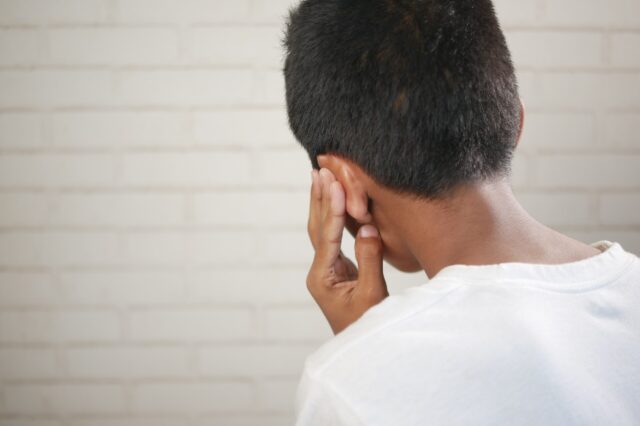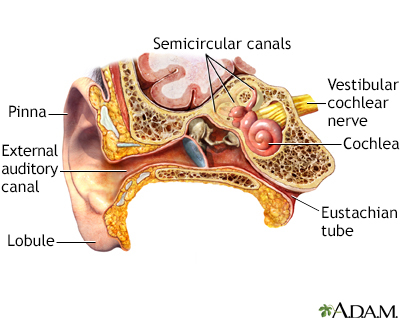UF Health Expert Answers FAQs on Ear Foreign Bodies
Children seem to have a fascination with putting objects into their ears. Whether it’s a marble, bead, cotton swab, pencil or even a bug, objects can easily…

Update your location to show providers, locations, and services closest to you.
Hearing loss is being partly or totally unable to hear sound in one or both ears.
Decreased hearing; Deafness; Loss of hearing; Conductive hearing loss; Sensorineural hearing loss; Presbycusis
Symptoms of hearing loss may include:
Associated symptoms may include:
Conductive hearing loss (CHL) occurs because of a mechanical problem in the outer or middle ear. This may be because:
Causes of conductive hearing loss can often be treated. They include:
Sensorineural hearing loss (SNHL) occurs when the tiny hair cells (nerve endings) that detect sound in the inner ear are injured, diseased, do not work correctly, or have died. This type of hearing loss often cannot be reversed.
Sensorineural hearing loss is commonly caused by:
Hearing loss may be present at birth (congenital) and can be due to:
The ear can also be injured by:
You can often flush wax buildup out of the ear (gently) with ear syringes (available in drug stores) and warm water. Wax softeners (like Cerumenex) may be needed if the wax is hard and stuck in the ear.
Take care when removing foreign objects from the ear. Unless it is easy to get to, have your health care provider remove the object. Don't use sharp instruments to remove foreign objects.
See your provider for any other hearing loss.
Contact your provider if:
The provider will take your medical history and do a physical exam.
Tests that may be done include:
The following surgeries may help some types of hearing loss:
The following may help with long-term hearing loss:
Cochlear implants are only used in people who have lost too much hearing to benefit from a hearing aid.

Arts HA, Adams ME. Sensorineural hearing loss in adults. In: Flint PW, Francis HW, Haughey BH, et al, eds. Cummings Otolaryngology: Head and Neck Surgery. 7th ed. Philadelphia, PA: Elsevier; 2021:chap 152.
Eggermont JJ. Types of hearing loss. In: Eggermont JJ, ed. Hearing Loss. Cambridge, MA: Elsevier Academic Press; 2017:chap 5.
Kerber KA, Baloh RW. Neuro-otology: diagnosis and management of neuro-otological disorders. In: Jankovic J, Mazziotta JC, Pomeroy SL, Newman NJ, eds. Bradley and Daroff's Neurology in Clinical Practice. 8th ed. Philadelphia, PA: Elsevier; 2022:chap 22.
Le Prell CG. Noise-induced hearing loss. In: Flint PW, Francis HW, Haughey BH, et al, eds. Cummings Otolaryngology: Head and Neck Surgery. 7th ed. Philadelphia, PA: Elsevier; 2021:chap 154.
Shearer AE, Shibata SB, Smith RJH. Genetic sensorineural hearing loss. In: Flint PW, Francis HW, Haughey BH, et al, eds. Cummings Otolaryngology: Head and Neck Surgery. 7th ed. Philadelphia, PA: Elsevier; 2021:chap 150.
Weinstein B. Disorders of hearing. In: Fillit HM, Rockwood K, Young J, eds. Brocklehurst's Textbook of Geriatric Medicine and Gerontology. 8th ed. Philadelphia, PA: Elsevier, 2017:chap 96.
Our community and patient programs provide great value to patients, families and loved ones. People can find support, educational materials, expert consultants and more. In most instances, these programs are offered free of charge.
Provides training and consults with the families and educational teams of Florida’s children and young adults (ages 0-22) with concurrent hearing loss and vision loss.
Children seem to have a fascination with putting objects into their ears. Whether it’s a marble, bead, cotton swab, pencil or even a bug, objects can easily…

For anyone deciding whether to get a cochlear implant, Adrienne Lovette and her son, Kamari, give their resounding support with two simple words: “Do it!”…

Listen up: Eating a healthy diet may reduce the risk of hearing loss. Researchers at Boston’s Brigham and Women’s Hospital examined data that tracked three-year changes in hearing sensitivities and...
You might imagine that noise-induced hearing loss is brought about purely by physical force, the result of intense sound waves hammering the eardrum or the tiny bones in the middle ear. Actually,...
The sound of silence is rare in a household with a baby. In an attempt to soothe their infant to sleep, many parents turn to sound machines to produce nature sounds or white noise … but how much...